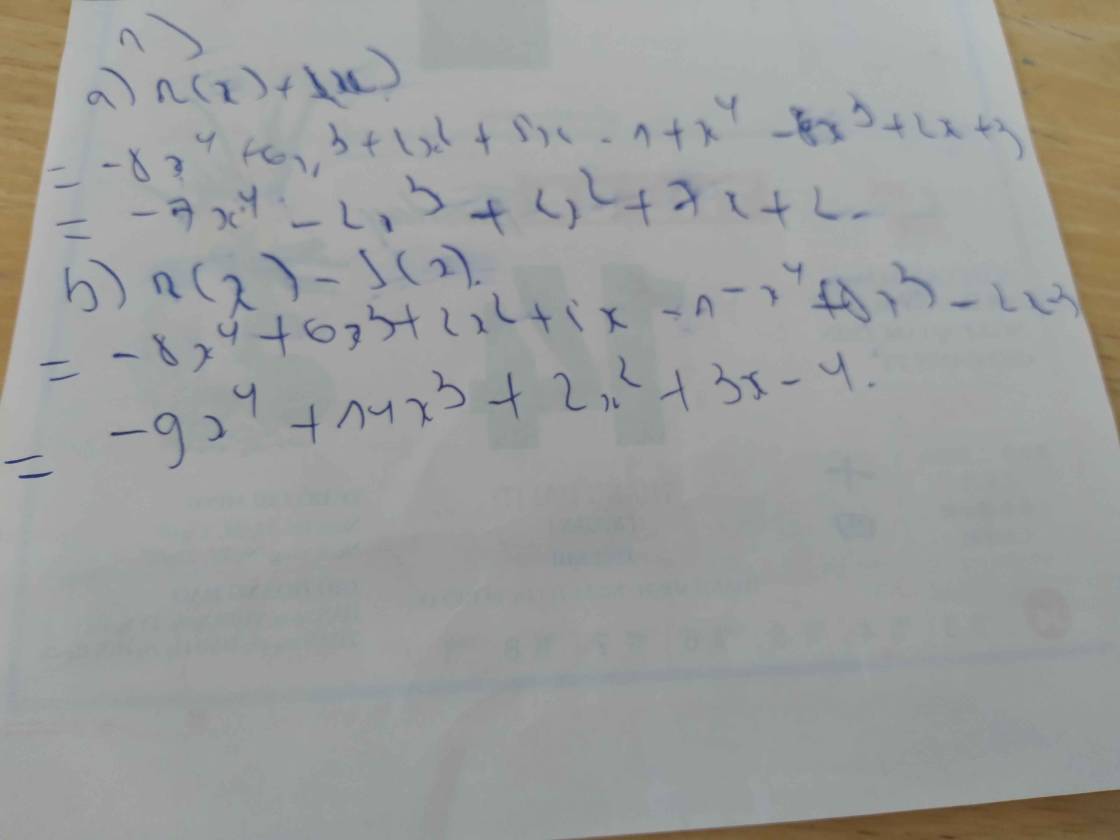Hãy nhập câu hỏi của bạn vào đây, nếu là tài khoản VIP, bạn sẽ được ưu tiên trả lời.

P(x)+Q(x)+R(x) = \(9{x^4} - 3{x^3} + 5x - 1 - 2{x^3} - 5{x^2} + 3x - 8 - 2{x^4} + 4{x^2} + 2x - 10\)
\(\begin{array}{l} = (9{x^4} - 2{x^4})+( - 3{x^3} - 2{x^3})+( - 5{x^2} + 4{x^2}) +( 5x + 3x + 2x)+( - 8 - 10 - 1)\\ = 7{x^4} - 5{x^3} - {x^2} + 10x - 19\end{array}\)
P(x)-Q(x)-R(x) = \(9{x^4} - 3{x^3} + 5x - 1 + 2{x^3} + 5{x^2} - 3x + 8 + 2{x^4} - 4{x^2} - 2x + 10\)
\(\begin{array}{l} = (9{x^4} + 2{x^4})+( - 3{x^3} + 2{x^3} )+ (5{x^2} - 4{x^2}) + (5x - 3x - 2x) + (10 - 1 + 8)\\ = 11{x^4} - {x^3} + {x^2} + 17\end{array}\)

a) \(P\left(x\right)=3x^3-2x+2x^2+7x+8-x^4)\)
\(P\left(x\right)=3x^3(-2x+7x)+2x^2+8-x^4)\)
\(P\left(x\right)=3x^3+5x+2x^2+8-x^4)\)
\(P\left(x\right)=-x^4+3x^3+2x^2+5x+8\)
\(Q\left(x\right)=2x^2-3x^3+3x^2-5x^4\)
\(Q\left(x\right)=(2x^2+3x^2)-3x^3-5x^4\)
\(Q\left(x\right)=5x^2-3x^3-5x^4\)
\(Q\left(x\right)=-5x^4-3x^2+5x^2\)
b)
\(P\left(x\right)+Q\left(x\right)=(3x^3-2x+2x^2+7x+8-x^4)+\left(2x^2-3x^3+3x^2-5x^4\right)\)
\(P\left(x\right)+Q\left(x\right)=3x^3-2x+2x^2+7x+8-x^4+2x^2-3x^3+3x^2-5x^4\)
\(P\left(x\right)+Q\left(x\right)=\left(3x^3-3x^3\right)+\left(-2x+7x\right)+\left(2x^2+2x^2+3x^2\right)+8+\left(-x^4-5x^4\right)\)\(P\left(x\right)+Q\left(x\right)=5x+7x^2+8-6x^4\)
Vậy: \(R\left(x\right)\) \(=5x+7x^2+8-6x^4\)
c. \(R\left(x\right)\) \(=5x+7x^2+8-6x^4\)
\(=5x+7x^2+4+4-6x^4\)
\(=\) \((12x-4)^2+4\ge4-6x^4\)
Câu c MIK KHÔNG CHẮC LÀ ĐÚNG

Tìm nghiệm của đa thức sau:
a) P(x)= x2+4x+3
x2 + 4x + 3 = 0
<=> x2 + x + 3x + 3 = 0
<=> x(x + 1) + 3(x + 1) = 0
<=> (x + 1)(x + 3) = 0
\(\Leftrightarrow\orbr{\begin{cases}x+1=0\\x+3=0\end{cases}\Leftrightarrow\orbr{\begin{cases}x=-1\\x=-3\end{cases}}}\)
Vậy x = -1 ; x = -3 là nghiệm của đa thức P(x)
b) Q(x)= 2x2-5x+3
2x2 - 5x + 3 = 0
<=> 2x2 - 2x - 3x + 3 = 0
<=> (2x2 - 2x) - (3x - 3) = 0
<=> 2x(x - 1) - 3(x - 1) = 0
<=> (x - 1)(2x - 3) = 0
\(\Leftrightarrow\orbr{\begin{cases}x-1=0\\2x-3=0\end{cases}\Leftrightarrow\orbr{\begin{cases}x=1\\x=\frac{3}{2}\end{cases}}}\)
Vậy x = 1 ; x = 3/2 là nghiệm của đa thức Q(x)
c) R(x)= 2x2-x-1
2x2 - x - 1 = 0
<=> 2x2 - 2x + x - 1 = 0
<=> 2x(x - 1) + (x - 1) = 0
<=> (x - 1)(2x + 1) = 0
\(\Leftrightarrow\orbr{\begin{cases}x-1=0\\2x+1=0\end{cases}\Leftrightarrow\orbr{\begin{cases}x=1\\x=\frac{-1}{2}\end{cases}}}\)
Vậy x = 1 ; x = -1/2 là nghiệm của đa thức R(x)
d) S(x)= 3x2-x-4
3x2 - x - 4 = 0
<=> 3x2 + 3x - 4x - 4 = 0
<=> (3x2 + 3x) - (4x + 4) = 0
<=> 3x(x + 1) - 4(x + 1) = 0
<=> (x + 1)(3x - 4) = 0
\(\Leftrightarrow\orbr{\begin{cases}x+1=0\\3x-4=0\end{cases}\Leftrightarrow\orbr{\begin{cases}x=-1\\x=\frac{4}{3}\end{cases}}}\)
Vậy x = -1 ; x = 4/3 là nghiệm của đa thức S(x)

\(P\left(x\right)+Q\left(x\right)=\left(2x^4+x^3-4x+5\right)+\left(x^4+3x^3+2x-1\right)\)
\(=2x^4+x^3-4x+5+x^4+3x^3+2x-1\)
\(=\left(2x^4+x^4\right)+\left(x^3+3x^3\right)+\left(-4x+2x\right)+\left(5-1\right)\)
\(=3x^4+4x^3-2x+4\)
\(R\left(x\right)+P\left(x\right)=x^4-2x^2+1\)
\(\Rightarrow R\left(x\right)=\left(x^4-2x^2+1\right)-P\left(x\right)\)
\(\Rightarrow R\left(x\right)=\left(x^4-2x^2+1\right)-\left(2x^4+x^3-4x+5\right)\)
\(\Rightarrow R\left(x\right)=x^4-2x^2+1-2x^4-x^3+4x-5\)
\(\Rightarrow R\left(x\right)=\left(x^4-2x^4\right)+\left(-2x^2\right)+\left(1-5\right)+\left(-x^3\right)+4x\)
\(\Rightarrow R\left(x\right)=-x^4-2x^2-4-x^3+4x\)

a: Q(x)=3x^4+x^3+2x^2+x+1-2x^4+x^2-x+2
=x^4+x^2+3x^2+3
b: H(x)=2x^4-x^2+x-2-x^4+x^3-x^2+2
=x^4+x^3-2x^2+x
c: R(x)=2x^3+x^2+1+2x^4-x^2+x-2
=2x^4+2x^3+x-1

Tổng 2 đa thức:
\(\begin{array}{l}A(x) + B(x) = - 8{x^5} + 6{x^4} + 2{x^2} - 5x + 1 + 8{x^5} + 8{x^3} + 2x - 3\\ = ( - 8 + 8){x^5} + 6{x^4} + 8{x^3} + 2{x^2} + ( - 5 + 2)x + (1 - 3)\\ = 6{x^4} + 8{x^3} + 2{x^2} - 3x - 2\end{array}\)
Vậy bậc của hai đa thức là tổng là: 4.
Hiệu 2 đa thức:
\(\begin{array}{l}A(x) - B(x) = - 8{x^5} + 6{x^4} + 2{x^2} - 5x + 1 - (8{x^5} + 8{x^3} + 2x - 3)\\ = - 8{x^5} + 6{x^4} + 2{x^2} - 5x + 1 - 8{x^5} - 8{x^3} - 2x + 3\\ = ( - 8 - 8){x^5} + 6{x^4} - 8{x^3} + 2{x^2} + ( - 5 - 2)x + (1 + 3)\\ = - 16{x^5} + 6{x^4} - 8{x^3} + 2{x^2} - 7x + 4\end{array}\)
Vậy bậc của hai đa thức là hiệu là: 5

a) \(R(x) = - 2{x^2} + 3{x^2} + 6x + 8{x^4} - 1 = ( - 2{x^2} + 3{x^2}) + 6x + 8{x^4} - 1 = {x^2} + 6x + 8{x^4} - 1\).
b) Trong các đơn thức của đa thức R(x) ta thấy, số mũ lớn nhất là 4, sau đó đến 2; 1 và 0.
Vậy \(R(x) = {x^2} + 6x + 8{x^4} - 1 = 8{x^4} + {x^2} + 6x - 1\).

a)
\(\begin{array}{l}R(x) + S(x) = - 8{x^4} + 6{x^3} + 2{x^2} - 5x + 1 + {x^4} - 8{x^3} + 2x + 3\\ = ( - 8 + 1){x^4} + (6 - 8){x^3} + 2{x^2} + ( - 5 + 2)x + (1 + 3)\\ = - 7{x^4} - 2{x^3} + 2x - 3x + 4\end{array}\)
b)
\(\begin{array}{l}R(x) - S(x) = - 8{x^4} + 6{x^3} + 2{x^2} - 5x + 1 - ({x^4} - 8{x^3} + 2x + 3)\\ = - 8{x^4} + 6{x^3} + 2{x^2} - 5x + 1 - {x^4} + 8{x^3} - 2x - 3\\ = ( - 8 - 1){x^4} + (6 + 8){x^3} + 2{x^2} + ( - 5 - 2)x + (1 - 3)\\ = - 9{x^4} + 14{x^3} + 2x - 7x - 2\end{array}\)